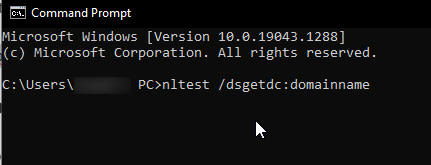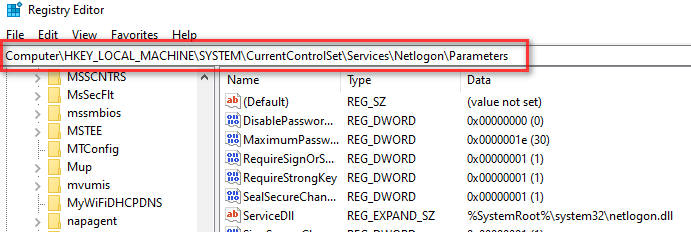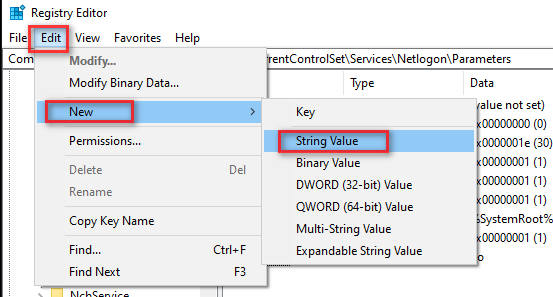If you’re troubleshooting a Windows domain issue, you might need to change the domain controller that a client machine is connected to.
But, if you don’t know how you switch domain controllers on a Windows computer, don’t worry.

Here, I will show you the best method to switch domain controllers on a Windows computer. This method has helped me to figure out if the network has a malfunctioning domain controller.
Keep reading the whole post, and make sure you follow my step-by-step instructions.
How To Find Current Domain Controller
You first find out the current domain controller when switching domain controllers on your client’s computer. Without the current domain controller, you can’t switch the domain controller on your client’s computer.
Here are the steps to get the domain controller on Windows:
- Press Windows Key to open Start Menu or
- Click on the Start button to open Start Menu.
- Type CMD to open Command Prompt.
- Hold the Shift button on your keyboard and right-click on Command Prompt.
- Choose Run as a different user.
- Fill in the information for a Domain Admin user account.
- Type nltest /dsgetdc:domainname at the Command Prompt.

Follow our guide to Fix Windows Resource Protection Could Not Start.
How To Switch Domain Controller Command
When debugging a Windows domain issue, you may need to change the domain controller that a client computer is connected to.
After getting the current domain controller, you can switch the domain controller on your client’s computer.
Here are the steps to switch the domain controller on the computer:
- Press Windows Key to open Start Menu or
- Click on the Start button to open Start Menu.
- Type CMD to open Command Prompt.
- Hold the Shift button on your keyboard and right-click on Command Prompt.
- Choose Run as a different user.
- Fill in the information for a Domain Admin user account.
- Type nltest /Server:ClientComputerName /SC_RESET:DomainName\DomainControllerName at the Command Prompt.

Note: This choice isn’t permanent, as a restart of the machine may result in a new DC being selected.
Also read, Should you Re-install Windows with A New CPU.
How To Set Domain Controller Via Registry
After switching the domain controller successfully, you are now able to set the domain controller via registry.
Follow these steps to set domain controller via registry:
- Press and hold Windows Key + R on your keyboard to open the Windows Run program.
- Type Regedit and hit the Enter button.
- Go to the HKEY_LOCAL_MACHINE folder. Then navigate the SYSTEM \CurrentControlSet\Services\Netlogon\Parameters folder.

- Click Edit on the menu bar, then select new and create a String value called SiteName.

- Fill it with the domain controller name to which the computer should connect. Example: DC1.domain.com is an example of such a domain.
You may like to read: Fix A Referral Returned from The Server Error Windows.
How To Force Client To Use Specific Domain Controller
You can force your clients to use specific domain controllers on their windows system computers. To force the client to use a specific domain controller, you need to follow these steps:
- Press and hold Windows Key + R on your keyboard to open the Windows Run program.
- Type Regedit and hit the Enter button.
- Open the HKEY_LOCAL_MACHINE folder. Then navigate the SYSTEM\CurrentControlSet\Services\Netlogon\Parameters folder.

- Click the Edit option on the menu bar. Select new and create a DWORD (32 -bit) value.
- Enter NodeType and press ENTER button.
- Set the new value to 4 . This sets the network to M-mode/mixed, which means it will broadcast before contacting name servers for resolution.
- If no WINS servers are configured (B-node/broadcast), the system defaults to 1; if at least one WINS server is configured (H-node/queries name resolution first, then broadcasts), it defaults to 8.
- Set EnableLMHOSTS to 1 by double-clicking on the value. If it doesn’t exist, go to the Edit menu and choose New to create DWORD (32 -bit) value, then EnableLMHOSTS as the name.
- Restart the system after closing the registry editor.
Follow our epic guide to Fix Windows Error Reporting High CPU and Disk Usage.
How To Change Logon Server On Windows
Client logons are enabled or disabled, and the current logon status is displayed. This program helps keep your computer in good working order. An administrator can only perform this command.
You won’t be able to reconnect to your session if you disable logons and log off before re-enabling logons when connected to the Remote Desktop Session Host server from a client session. Log on to the console to re-enable logons from client sessions.
It’s important to remember when you restart the computer, and logons are re-enabled.
Follow the syntax below to change the logon server on windows:
Syntax: change logon {/query | /enable | /disable | /drain | /drainuntilrestart}
Parameters Description
| Parameter | Description |
|---|---|
| /query | Shows whether the logon is enabled or disabled at the moment. |
| /enable | Logons from client sessions are allowed, but not from the console. |
| /disable | Continued logons from client sessions are disabled but not from the console. It does not affect users who are currently logged in. |
| /drain | Allows reconnections to current client sessions but disables logons from new client sessions. |
| /drainuntilrestart | Allows reconnections to existing sessions but disables logons from new client sessions until the computer is restarted. |
| /? | At the command prompt, this command displays help. |
Examples of Parameters
Type the following command to get the current logon status:
Syntax: change logon /query
Type the following command to enable logins from client sessions:
Syntax: change logon /enable
Type the following command to disable client logons:
Syntax: change logon /disable
How Nltest Change Domain Controller
In Windows Server, Nltest is a popular command-line tool. Windows Server 2008 and Windows Server 2008 R2 have a Nltest command-line tool.
If you have the AD DS or AD LDS server roles installed, you can use the Nltest command-line tool. It’s also included in the Remote Server Administration Tools if you install the Active Directory Domain Services Tools (RSAT).
To use the Nltest command-line tool, you can change the domain controller. You must run the Nltest command from an administrative command prompt to use it.
Follow the steps below to know how Nltest change the domain controller:
- Press Windows Key to open Start Menu or
- Click on the Start button to open Start Menu.
- Type CMD to open Command Prompt.
- Hold the Shift button on your keyboard and right-click on Command Prompt.
- Choose Run as a different user.
- Fill in the information for a Domain Admin user account.
- Type nltest /Server:ClientComputerName /SC_RESET:DomainName\DomainControllerName at the Command Prompt.
Read more on how to Enable or Disable UAC on Windows 11.
Final Thoughts
Domains are a hierarchical method of organizing users and computers that share a network. A domain controller is a computer network server that handles authentication requests and verifies users.
When you’re troubleshooting a Windows domain issue, you can change the client machine domain controller. All of the data is structured and protected by the domain controller.
Here, you learn how you find, switch or change, and set domain controller on windows. Also, learn how to force the client to use a specific domain controller and force the client to use a specific domain controller.
I hope this post is helpful for you. Leave a comment below to share your opinion, and also, feel free to share your experience with your friends and other readers.




